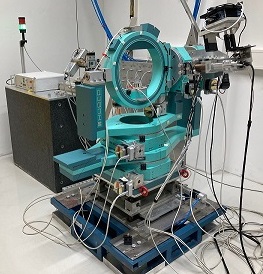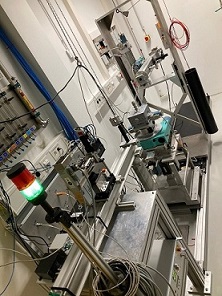6-circle (PSIC) diffractometer using a Cu source
Responsible: Dr. Vedran Vonk
The DESY Nanolab operates three separate X-ray set-ups which are all controlled via SPEC software. Different point-, stripe- and area detectors are available. Each set-up is placed within a shielded experimental hutch and monitored with an interlock system.
The first set-up is a dedicated X-ray reflectometer (XRR), equipped with a molybdenum X-ray tube and adapted focusing multilayer optics. Typically, theta-2theta scans with a vertical scattering plane are performed with SPEC's FOURC geometry code.
The second machine is a full 6-circle X-ray diffractometer for grazing incidence geometry (so-called Z-axis). It is used in combination with a copper X-ray tube and multilayer focusing optics. It is run with SPEC's SIXC geometry code.
The third device is a full 6-circle X-ray diffractometer (a so-called PSIC geometry). It gives access to reciprocal space in various geometries, also grazing incidence. It is run with SPEC's PSIC geometry code.
The X-ray lab is situated in building 25, EG 023.
Reflectometer
Characteristics
Mo-Kalpha
• spot size: 2x0.9 mm2 (HxV)
• divergence: parallel
• type: theta-2theta scans
• control software: SPEC-FOURC
• detectors: Point or area detector (Maxipix)
Six-circle Diffractometer (SIXC)
Characteristics
Cu-Kalpha
• spot size: 0.25x0.25 mm2 (HxV)
• divergence: 5x5 mrad2 (HxV)
• type: full reciprocal space access
• control software: SPEC.SIXC
• detectors: Point detector or area detector (Mythen)
Six-circle Diffractometer (PSIC)
Characteristics
Cu-Kalpha
• spot size: 0.5x0.5 mm2 (HxV)
• divergence: 2x2 mrad2 (HxV)
• type: full reciprocal space access
• control software: SPEC-PSIC
• detectors: Point detector
Contact:
Dr. Vedran Vonk
Tel. +49 (0)40 - 8998 6012
vedran.vonk@desy.de
Dipl. Ing.(FH) Simon Geile
Tel. +49 (0)40 - 8998 6019
simon.geile@desy.de
6-circle (SIXC) heavy load diffractometer using a Cu source








